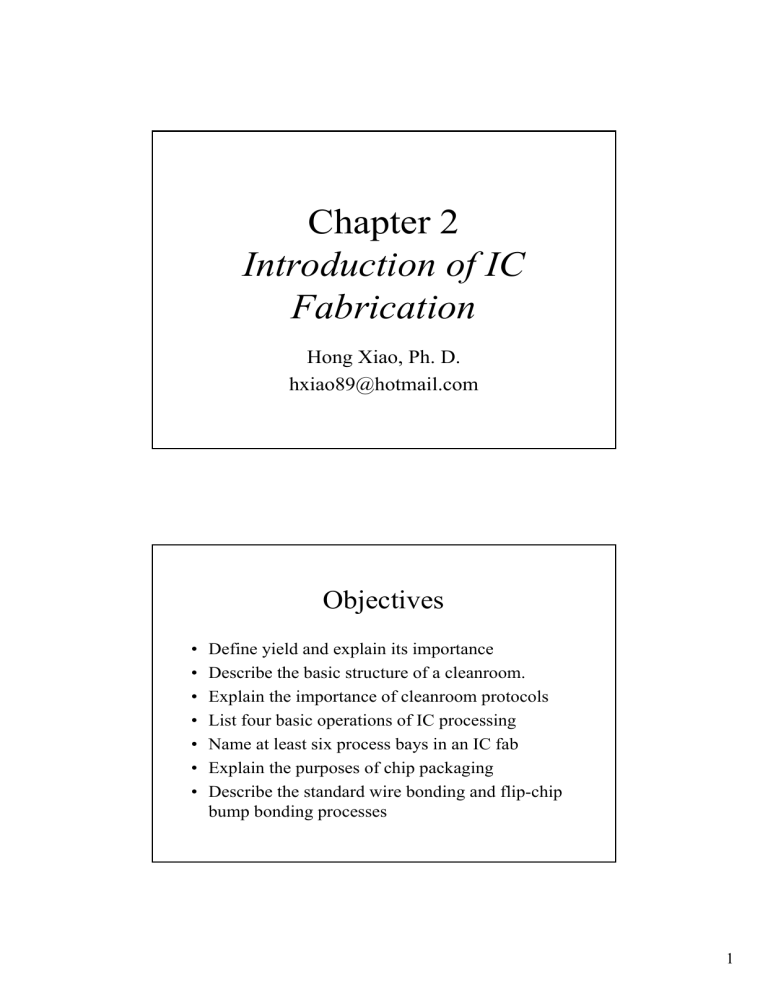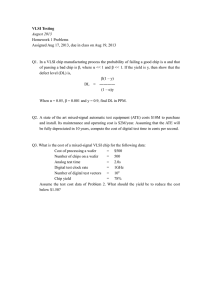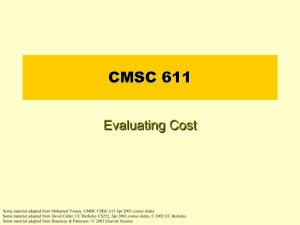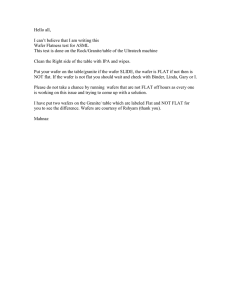IC Fabrication: Yield, Cleanrooms, and Packaging
advertisement

Chapter 2 Introduction of IC Fabrication Hong Xiao, Ph. D. hxiao89@hotmail.com Objectives • • • • • • • Define yield and explain its importance Describe the basic structure of a cleanroom. Explain the importance of cleanroom protocols List four basic operations of IC processing Name at least six process bays in an IC fab Explain the purposes of chip packaging Describe the standard wire bonding and flip-chip bump bonding processes 1 Yield To produce Especially for function test after finished all IC process “Yield” relative to : Engineers skill Environment Used materials Purchased equipment Process Wafer Process Flow Materials IC Fab Metallization CMP Dielectric deposition Test Wafers Thermal Processes Implant PR strip Etch PR strip Packaging Masks Photolithography Final Test Design 2 Fab Cost • • • • • • Fab cost is very high, > $1B for 8” fab Clean room Equipment, usually > $1M per tool Materials, high purity, ultra high purity Facilities People, training and pay Wafer Yield YW = Wafers good Waferstotal Depends on : processing ; handling ; robot function ; alignment and so on 3 Die Yield YD = Dies good Dies total Depends on : contamination, maintenance Packaging Yield YC = Chips good Chips total Depends on : bonding quality 4 Overall Yield YT = YW×YD×YC Overall Yield determines whether a fab is making profit or losing money How Does Fab Make (Loss) Money • Cost: – Wafer (8”): ~$150/wafer* – Processing: ~$1200 ($2/wafer/step, 600 steps) – Packing: ~$5/chip • Sale: – ~200 chips/wafer – ~$50/chip (low-end microprocessor in 2000) *Cost of wafer, chips per wafer, and price of chip varies, numbers here are choosing randomly based on general information. 5 How Does a Fab Make (Loss) Money Cost: • 100% yield: 150+1200+1000 = $2350/wafer • 50% yield: 150+1200+500 = $1850/wafer • 0% yield: 150+1200 = $1350/wafer Sale: • 100% yield: 200×50 = $10,000/wafer • 50% yield: 100×50 = $5,000/wafer • 0% yield: 0×50 = $0.00/wafer • 100% yield: 10000 − 2350 = $7650/wafer Profit Margin: • 50% yield : 5000 − 1850 = $3150/wafer • 0% yield : 0 − 1350 = − $1350/wafer Question • If yield for every process step is 99%, what is the overall processing yield after 600 process steps? 6 Answer • It equals to 99% times 99% 600 times • 0.99600 = 0.0024 = 0.24% • Almost no yield Throughput • Number of wafers able to process – Fab: wafers/month (typically 10,000) – Tool: wafers/hour (typically 60) • At high yield, high throughput brought 7 Defects and Yield 1 Y∝ (1 + DA) n Y : Overall yield D : Defect density A : Chip area n : Process Steps To achieve 100% overall yield : defect must be zero for each process For the same defect density and chip size : the more process steps , the lower yield For the same defect density : the larger chip size, the lower yield Yield and Die Size Killer Defects Y = 28/32 = 87.5% Y = 2/6 = 33.3% 8 Illustration of a Production Wafer Die Test die Illustration of a Production Wafer Test Structures Scribe Lines Dies 9 Clean Room • Artificial environment with low particle counts • Started in medical application for post-surgery infection prevention • Particles kills yield • IC fabrication must in a clean room • Smaller feature size, requires higher grade purity in clean room Clean Room • First used for surgery room to avoid bacteria contamination • Adopted in semiconductor industry in 1950 • Smaller device needs higher grade clean room • Less particle, more expensive to build 10 Clean Room Class • Class 10 is defined as less than 10 particles with diameter larger than 0.5 µm per cubic foot. • Class 1 is defined as less than 1 such particles per cubic foot. • 0.18 mm device require higher than Class 1 grade clean room. Cleanroom Classes 100000 Cl # of particles / ft3 10000 Cl 1000 100 Cl 10 1 0.1 Cl Cl a 0.1 as as Cl s1 0 as Cl s1 00 as as as s1 s1 s1 00 0, ,0 ,0 00 00 0 00 s1 ss M -1 1.0 10 Particle size in micron 11 Definition of Airborne Particulate Cleanliness Class per Fed. Std. 209E Particles/ft3 Class 0.1 µm 0.2 µm 0.3 µm 0.5 µm M-1 9.8 2.12 0.865 0.28 1 35 7.5 3 1 10 350 75 30 10 750 300 100 100 5 µm 1000 1000 7 10000 10000 70 Effect of Particles on Masks Particles on Mask Stump on +PR Hole on −PR Film Film Substrate Substrate 12 Effect of Particle Contamination Ion Beam Dopant in PR Particle Photoresist Screen Oxide Partially Implanted Junctions Cleanroom Structure Makeup Air Makeup Air Fans Equipment Area Class 1000 Process Tool Return Air HEPA Filter Class 1 Process Area Raised Floor with Grid Panels Equipment Area Class 1000 Process Tool Pump, RF and etc. 13 Mini-environment • Class 1000 cleanroom, lower cost • Boardroom arrangement, no walls between process and equipment • Better than class 1 environment around wafers and the process tools • Automatic wafer transfer between process tools Mini-Environment Cleanroom Makeup Air Makeup Air Fans HEPA Filter HEPA Filter < Class 1 Class 1000 Process Tool Return Air Class 1000 Raised Floor with Grid Panels Process Tool Pump, RF and etc. 14 Gowning Area Shelf of Gloves, Hair and Shoe Covers Gown Racks Disposal Bins Entrance Shelf of Gloves To Cleanroom Wash/Clean Stations Shelf of Gloves Storage Benches IC Fabrication Process Module Thin film growth, dep. and/or CMP Photolithography Etching Ion Implantation PR Stripping PR Stripping RTA or Diffusion 15 Illustration of Fab Floor Equipment Areas Process Bays Corridor Service Area Sliding Doors Gowning Area Mini-environment Fab Floor Process and metrology tools Service Area Emergency Exits Gowning Area 16 Wet Processes Etch, PR strip, or clean Dry Rinse Horizontal Furnace Heating Coils Quartz Tube Temperature Wafers Gas flow Center Zone Flat Zone Distance 17 Vertical Furnace Process Chamber Heaters Wafers Tower Schematic of a Track Stepper Integrated System Wafer Prep Chamber Spin Coater Chill Plates Stepper Chill Plates Developer Hot Plates Wafer Movement 18 Cluster Tool with Etch and Strip Chambers PR Strip Chamber Etch Chamber PR Strip Chamber Etch Chamber Robot Loading Station Transfer Chamber Unloading Station Cluster Tool with Dielectric CVD and Etchback Chambers O3-TOES Chamber Ar Sputtering Chamber PECVD Chamber Robot Loading Station Transfer Chamber Unloading Station 19 Cluster Tool with PVD Chambers Al⋅Cu Chamber Ti/TiN Chamber Al⋅Cu Chamber Ti/TiN Chamber Transfer Chamber Robot Loading Station Unloading Station Dry-in Dry-out CMP System Wafer Loading and Standby Polishing Pad Post-CMP Clean Polishing Heads Rinse Multi-head Polisher Dryer and Wafer Unloading Clean Station 20 Process Bay and Equipment Areas Sliding Doors Equipment Area Equipment Area Tables For PC and Metrology Tools Process Tools Process Area Service Area Wafer Loading Doors Test Results Failed die 21 Chip-Bond Structure Microelectronics Devices and Circuits Chip Backside Metallization Chip (Silicon) Melt and Condense Solder Substrate Metallization Substrate (Metal or Ceramic) Wire Bonding Metal Wire Wire Clamp Bonding Pad Bonding Pad Bonding Pad Formation of molten metal ball Press to make contact Head retreat 22 Wire Bonding Bonding Pad Lead Lead contact with pressure and heat Bonding Pad Lead Clamp closed with heat on to break the wire IC Chip with Bonding Pads Bonding Pads 23 IC Chip Packaging Chip Bonding Pad Pins Chip with Bumps Bumps 24 Flip Chip Packaging Bumps Chip Socket Pins Bump Contact Bumps Chip Socket Pins 25 Heating and Bumps Melt Bumps Chip Socket Pins Flip Chip Packaging Chip Socket Pins 26 Molding Cavity for Plastic Packaging Molding Cavity Top Chase Bonding Wires IC Chip Lead Frame Chip Bond Metallization Pins Bottom Chase Ceramic Seal Bonding Wires Cap Seal Metallization IC Chip Ceramic Cap Layer 2 Layer 2 Lead Frame, Layer 1 Pins Chip Bond Metallization 27 Summary • Overall yield • Yield determines losing money or making profit • Cleanroom and cleanroom protocols • Process bays • Process, equipment, and facility areas • Die test, wafer thinning, die separation, chip packaging, and final test 28



